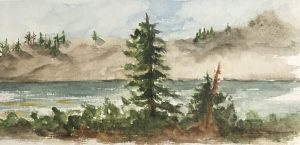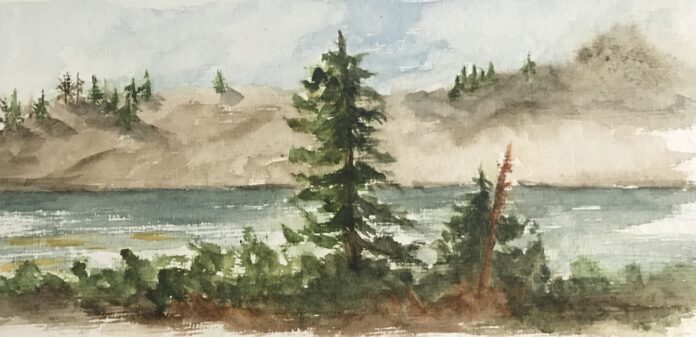BY LESLIE REGO

I was in the mood to paint water and so I decided to take the gentle trek to Baker Lake. I had just read an essay written by John Muir on glacier lakes the day before and was reliving some of his writings as I hiked. Muir remarks, “I first discovered this charming lake in the autumn of 1872, while on my way to the glaciers at the head of the river. It was rejoicing then in its gayest colors, untrodden, hidden in the glorious wildness like unmanned gold.” I cannot say that the trail to Baker Lake is untrodden, but it is like unmanned gold. It is one of my favorite short hikes.
The trail was lined with the seed head of monkshood, shaped like three pea pods stuck together, very much like the seed head of columbine but without the finely etched lines. There was flowering lupine and also the lupine pods containing the seeds for next year’s blooms.
Fireweed was prevalent, the individual flowers beginning to fade and the long red extension containing the white seeds starting to protrude. Scattered across the forest were asters. In fact, I counted many shades of purple and pink: the royal purple of monkshood, the lavender of asters, the soft purple/blues of lupine, the bright pink of fireweed, and the gentle pink of the very last buds of hollyhock. Interspersed throughout the purples and pinks were the complimentary yellows of goldenrod, groundsel and rabbitbrush. Yellow and purple, opposites on the color wheel, hollered out on the mountainside, drawing attention everywhere I looked.
The day was cool and I was able to take my time to paint the lake. I was intrigued by the mountain on the far side of the water. The slope was composed of loose scree. I suspect that small and large rocks flow into the lake with the melting of the snow or are pushed in from avalanches. Muir writes, “So the young lake grows in beauty, becoming more and more humanly lovable from century to century. Groves of aspen spring up, and hardy pines… until it is richly overshadowed and embowered. But while its shores are being enriched, the soil-beds creep out with incessant growth, contracting its area, while the lighter mud-particles deposited on the bottom cause it to grow constantly shallower, until at length the last remnant of the lake vanishes, closed forever in ripe and natural old age.”
What a vivid image of the passage of time! I am not sure how much smaller Baker Lake is today than it was years ago, but I sat there and painted the scene as it is now, a gem in the midst of the Sawtooth National Forest, hopefully with years left in its life cycle. My little painting portrays a slight moment in time, a sliver, within the life of a mountain lake.
Leslie Rego is an Idaho Press Club award-winning columnist, artist and Blaine County resident. To view more of Rego’s art, visit leslierego.com.



